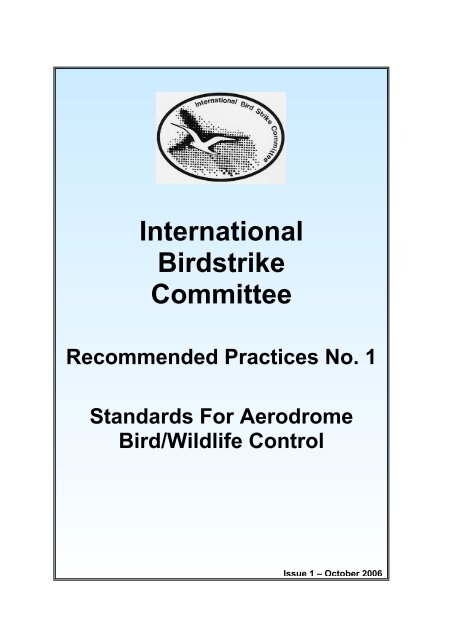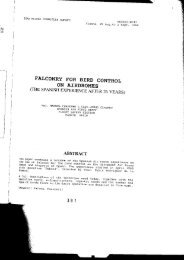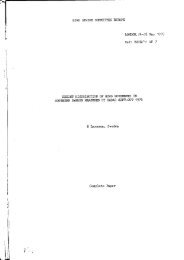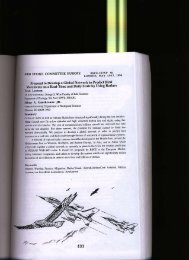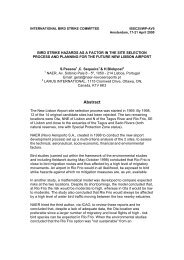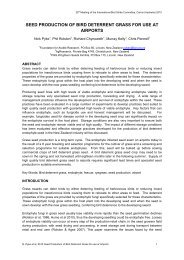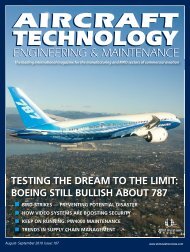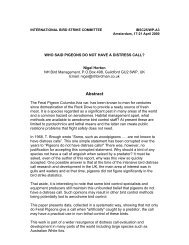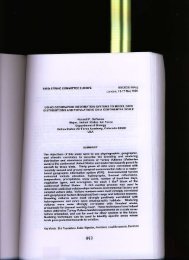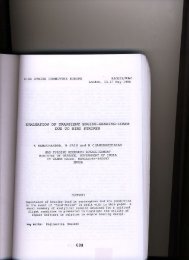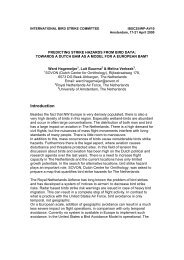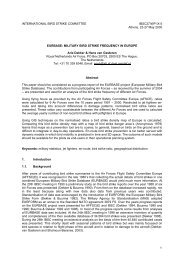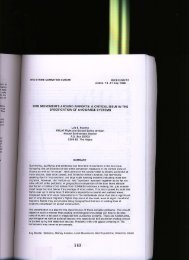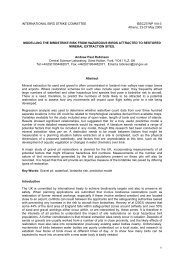Standards for aerodrome bird/wildlife control - International Bird ...
Standards for aerodrome bird/wildlife control - International Bird ...
Standards for aerodrome bird/wildlife control - International Bird ...
You also want an ePaper? Increase the reach of your titles
YUMPU automatically turns print PDFs into web optimized ePapers that Google loves.
<strong>International</strong><br />
<strong>Bird</strong>strike<br />
Committee<br />
Recommended Practices No. 1<br />
<strong>Standards</strong> For Aerodrome<br />
<strong>Bird</strong>/Wildlife Control<br />
Issue 1 – October 2006
CONTENTS<br />
Summary of <strong>Standards</strong> 3 - 5<br />
Introduction 6<br />
IBSC <strong>Standards</strong><br />
1. Airfield Habitat Management 7<br />
Background 7<br />
Standard 1 7<br />
Identifying attractions 7<br />
Habitat Management 8<br />
Standard 2 9<br />
2. Active <strong>Bird</strong>/Wildlife Control on the Airport 9<br />
Background 9<br />
Standard 3 9<br />
3. Organisation 10<br />
Background 10<br />
Collaboration and Coordination between organisations on the Airport 10<br />
4. Equipment 10<br />
Background 10<br />
Portable Equipment 11<br />
Static Devices 11<br />
Trained Predators (Falcons and Dogs) 12<br />
Standard 4 12<br />
5. Logging <strong>Bird</strong>/Wildlife Management Activities 13<br />
Background 13<br />
Standard 5 13<br />
6. <strong>Bird</strong>strike Reporting 13<br />
Background 13<br />
Definition of a <strong>Bird</strong>/Wildlife Strike 14<br />
Standard 6 14<br />
7. Analysis of <strong>Bird</strong>strike Data 15<br />
8. <strong>Bird</strong>/Wildlife Remains Identification 15<br />
9. Data Required in a <strong>Bird</strong>strike Report 16<br />
Standard 7 16<br />
10. Submission to ICAO 16<br />
11. Risk Assessment 17<br />
Standard 8 17<br />
12. <strong>Bird</strong>/Wildlife Management off the Airfield 17<br />
Identifying Attractions 17<br />
Management 18<br />
Standard 9 18<br />
References 19<br />
2
Summary Of IBSC <strong>Standards</strong> For Aerodrome <strong>Bird</strong>/Wildlife Control<br />
These best practice standards should apply to any <strong>aerodrome</strong> carrying<br />
regularly scheduled commercial air traffic, irrespective of the movement<br />
frequency or type of aircraft involved.<br />
Standard 1<br />
A named member of the senior management team at the airport should be<br />
responsible <strong>for</strong> the implementation of the <strong>bird</strong> <strong>control</strong> programme, including both<br />
habitat management and active <strong>bird</strong> <strong>control</strong>.<br />
Standard 2<br />
An airport should undertake a review of the features on its property that attract<br />
hazardous <strong>bird</strong>s/<strong>wildlife</strong>. The precise nature of the resource that the they are<br />
attracted to should be identified and a management plan developed to eliminate or<br />
reduce the quantity of that resource, or to deny <strong>bird</strong>s access to it as far as is<br />
practicable.<br />
Where necessary, support from a professional <strong>bird</strong>/<strong>wildlife</strong> strike prevention<br />
specialist should be sought.<br />
Documentary evidence of this process, its implementation and outcomes should<br />
be kept.<br />
Standard 3<br />
A properly trained and equipped <strong>bird</strong>/<strong>wildlife</strong> <strong>control</strong>ler should be present on the<br />
airfield <strong>for</strong> at least 15 minutes prior to any aircraft departure or arrival. Thus, if<br />
aircraft are landing or taking of at intervals of less than 15 minutes there should be<br />
a continuous presence on the airfield throughout daylight hours. The <strong>control</strong>ler<br />
should not be required to undertake any duties other than <strong>bird</strong> <strong>control</strong> during this<br />
time. Note that <strong>for</strong> <strong>aerodrome</strong>s with infrequent aircraft movements, 15 minutes<br />
may not be long enough to disperse all hazardous <strong>bird</strong>s/<strong>wildlife</strong> from the vicinity of<br />
the runway. In this case the <strong>control</strong>ler should be deployed sufficiently in advance<br />
of the aircraft movement to allow full dispersal to be achieved.<br />
At night, active runways and taxiways should be checked <strong>for</strong> the presence of<br />
<strong>bird</strong>s/<strong>wildlife</strong> at regular intervals and the dispersal action taken as needed.<br />
Standard 4<br />
<strong>Bird</strong> <strong>control</strong> staff should be equipped with <strong>bird</strong> deterrent devices appropriate to<br />
the <strong>bird</strong> species encountered, the numbers of <strong>bird</strong>s present, and to the area that<br />
they need to <strong>control</strong>. Staff should have access to appropriate devices <strong>for</strong> removal<br />
of <strong>bird</strong>s/<strong>wildlife</strong>, such as firearms or traps, or the means of calling on expert<br />
support to supply these techniques at short notice.<br />
All staff should receive proper training in the use of <strong>bird</strong> <strong>control</strong> devices.<br />
3
Standard 5<br />
Airport <strong>bird</strong>/<strong>wildlife</strong> <strong>control</strong>lers should record the following at least every 30<br />
minutes (if air traffic is sufficiently infrequent that <strong>bird</strong> patrols are more than 30<br />
minutes apart, an entry should be made <strong>for</strong> each patrol carried out).<br />
• areas of the airport patrolled,<br />
• numbers, location and species of <strong>bird</strong>s/<strong>wildlife</strong> seen,<br />
• action taken to disperse the <strong>bird</strong>s/<strong>wildlife</strong>,<br />
• results of the action.<br />
More general in<strong>for</strong>mation such as the name of the <strong>bird</strong> <strong>control</strong>ler on duty, time on<br />
and off duty, weather conditions etc should be recorded at the start of a duty<br />
period.<br />
Standard 6<br />
<strong>Bird</strong>/<strong>wildlife</strong> incidents should there<strong>for</strong>e be defined in 3 categories:<br />
Confirmed strikes:<br />
• Any reported collision between a <strong>bird</strong> or other <strong>wildlife</strong> and an aircraft <strong>for</strong><br />
which evidence in the <strong>for</strong>m of a carcass, remains or damage to the aircraft<br />
is found.<br />
• Any <strong>bird</strong>/<strong>wildlife</strong> found dead on an airfield where there is no other obvious<br />
cause of death (e.g. struck by a car, flew into a window etc.).<br />
Unconfirmed strikes:<br />
• Any reported collision between a <strong>bird</strong> or other <strong>wildlife</strong> and an aircraft <strong>for</strong><br />
which no physical evidence is found.<br />
Serious incidents:<br />
• Incidents where the presence of <strong>bird</strong>s/<strong>wildlife</strong> on or around the airfield has<br />
any effect on a flight whether or not evidence of a strike can be found.<br />
Standard 7<br />
Airports should establish a mechanism to ensure that they are in<strong>for</strong>med of all<br />
<strong>bird</strong>/<strong>wildlife</strong> strikes reported on or near their property.<br />
The total number of <strong>bird</strong>strikes should never be used as a measure of risk or of the<br />
per<strong>for</strong>mance of the <strong>bird</strong> <strong>control</strong> measures at an airport.<br />
Airports should ensure that the identification of the species involved in <strong>bird</strong>strikes<br />
is as complete as possible.<br />
Airports should record all <strong>bird</strong>strikes and include, as far as they are able, the data<br />
required <strong>for</strong> the standard ICAO reporting <strong>for</strong>m<br />
National Regulators should collate <strong>bird</strong>strike data and submit this to ICAO<br />
annually.<br />
4
Standard 8<br />
Airports should conduct a <strong>for</strong>mal risk assessment of their <strong>bird</strong>strike situation and<br />
use the results to help target their <strong>bird</strong> management measures and to monitor their<br />
effectiveness. Risk assessments should be updated at regular intervals, preferably<br />
annually<br />
.<br />
Standard 9<br />
Airports should conduct an inventory of <strong>bird</strong> attracting sites within the ICAO<br />
defined 13km <strong>bird</strong> circle, paying particular attention to sites close to the airfield<br />
and the approach and departure corridors. A basic risk assessment should be<br />
carried out to determine whether the movement patterns of <strong>bird</strong>s/<strong>wildlife</strong> attracted<br />
to these sites means that they cause, or may cause, a risk to air traffic. If this is the<br />
case, options <strong>for</strong> <strong>bird</strong> management at the site(s) concerned should be developed<br />
and a more detailed risk assessment per<strong>for</strong>med to determine if it is possible and/or<br />
cost effective to implement management processes at the site(s) concerned. This<br />
process should be repeated annually to identify new sites or changes in the risk<br />
levels produced by existing sites.<br />
Where national laws permit, airports, or airport authorities, should seek to have an<br />
input into planning decisions and land use practices within the 13km <strong>bird</strong> circle <strong>for</strong><br />
any development that may attract significant numbers of hazardous <strong>bird</strong>s/<strong>wildlife</strong>.<br />
Such developments should be subjected to a similar risk assessment process as<br />
described above and changes sought, or the proposal opposed, if a significant<br />
increase in <strong>bird</strong>strike risk is likely to result.<br />
5
INTRODUCTION<br />
Several excellent handbooks exist that describe in detail the techniques that can be<br />
used to manage the <strong>bird</strong>/<strong>wildlife</strong> strike risk on <strong>aerodrome</strong>s (e.g. ACI 2005, CAA 1998,<br />
Cleary & Dolbeer 1999, Transport Canada 2001). There has, however, been little<br />
attempt to determine the levels of investment in time, manpower, equipment, training<br />
and monitoring that are needed to effectively manage the <strong>bird</strong>/<strong>wildlife</strong> hazard. This<br />
contrasts with other <strong>aerodrome</strong> safety provisions, such as levels of fire <strong>control</strong><br />
equipment and manpower, that are precisely defined by regulation. This situation has<br />
arisen, in part, because the levels of risk, the habitat type, and the <strong>bird</strong>/<strong>wildlife</strong><br />
species present at different <strong>aerodrome</strong>s varies, and the precise techniques that are<br />
successful at one site may not work at another. It is also partly due to differences in<br />
the levels of resources available at different airports and to differences in the attitude<br />
of airport managers and national regulators to the risk posed by <strong>bird</strong>/<strong>wildlife</strong> strikes.<br />
The new <strong>International</strong> Civil Aviation Organisation <strong>Standards</strong> And Recommended<br />
Practices (SARPS) on airport <strong>bird</strong>/<strong>wildlife</strong> <strong>control</strong> became effective in November<br />
2003. The guidance material accompanying the SARPS is in the process of being<br />
updated. This guidance will, when combined with the various manuals listed above,<br />
provide the technical detail needed to construct a <strong>bird</strong>/<strong>wildlife</strong> <strong>control</strong> programme. It<br />
does not, however, describe the levels of ef<strong>for</strong>t that are needed if a <strong>bird</strong> <strong>control</strong><br />
programme is to operate effectively. It was there<strong>for</strong>e agreed at the 26 th meeting of<br />
IBSC in Warsaw that a set of IBSC standards should be developed by the committee<br />
to address this issue.<br />
This paper seeks to identify those areas where universally applicable practices can<br />
be identified, and suggests levels of airfield habitat management, <strong>bird</strong> <strong>control</strong><br />
equipment, manpower, etc. that, in the opinion of the IBSC membership, an airport<br />
should have in place if it is to effectively manage the <strong>bird</strong>strike risk to aircraft. It is<br />
envisaged that these standards will in<strong>for</strong>m airport managers, national regulators, the<br />
insurance industry, lawyers etc. about what they should expect to see invested in<br />
<strong>bird</strong>/<strong>wildlife</strong> <strong>control</strong> at an airport. Airports with unusually high <strong>bird</strong>/<strong>wildlife</strong> strike risk <strong>for</strong><br />
whatever reason would be expected to invest more in strike prevention than is<br />
described below in order to reduce that risk.<br />
There are clearly many private <strong>aerodrome</strong>s that are too small to justify the provision<br />
of <strong>bird</strong>/<strong>wildlife</strong> <strong>control</strong> to the levels described in this document. However, in the<br />
opinion of IBSC, these standards should apply to any <strong>aerodrome</strong> carrying<br />
regularly scheduled commercial air traffic, irrespective of the movement<br />
frequency or type of aircraft involved.<br />
No attempt has been made to provide a detailed scientific underpinning <strong>for</strong> the best<br />
practices proposed. Those wishing to explore the underlying science in more depth<br />
are referred to previous volumes of the proceedings of IBSC ( www.int-<strong>bird</strong>strike.com<br />
), <strong>Bird</strong>strike Committee Europe, <strong>Bird</strong>strike Committee N. America (www.<strong>bird</strong>strike.org<br />
and www.<strong>bird</strong>strikecanada.com), German <strong>Bird</strong>strike Committee ( www.davvl.de ),<br />
and the scientific literature. The aim of this document is to distill collective experience<br />
of ornithological and aviation experts into a set of basic standards that the aviation<br />
industry as a whole can use.<br />
6
IBSC STANDARDS<br />
1. Airfield Habitat Management<br />
Background<br />
Controlling the attractiveness of an airport to <strong>bird</strong>s and other <strong>wildlife</strong> is fundamental to<br />
good <strong>bird</strong> <strong>control</strong>. Indeed, it is probably more important than <strong>bird</strong> dispersal in terms of<br />
<strong>control</strong>ling the overall risk. If an airport provides easily accessible resources to<br />
<strong>bird</strong>s/<strong>wildlife</strong> in terms of food, water, shelter or breeding sites, then they will continue<br />
to try and return despite any dispersal tactics that are used to dissuade them. The<br />
<strong>control</strong> programme is thus doomed to failure unless the airport is made as<br />
unattractive to <strong>bird</strong>s/<strong>wildlife</strong> as possible. Habitat management to deter <strong>bird</strong>s/<strong>wildlife</strong><br />
involves two processes, identifying the attractive features and implementing changes<br />
to either remove the attraction or to deny access to it.<br />
Habitat management, such as improving<br />
drainage, installing fences, modifying<br />
vegetation cover etc. is frequently<br />
expensive. It is often difficult to obtain<br />
resources <strong>for</strong> programmes which, in the<br />
case of vegetation modification, may take<br />
a number of years to fully implement, and<br />
the benefits of which are not always<br />
immediately apparent to airport<br />
managers. Commitment to the process<br />
from senior managers is there<strong>for</strong>e<br />
essential and a named member of the<br />
airport’s senior management should take<br />
responsibility <strong>for</strong> ensuring that this, and<br />
other parts of the <strong>bird</strong>/<strong>wildlife</strong> hazard<br />
management programme are carried out<br />
properly.<br />
Overgrown ditches like this provide good shelter<br />
and nesting cover <strong>for</strong> hazardous <strong>bird</strong>s<br />
Standard 1<br />
A named member of the senior management team at the airport should be<br />
responsible <strong>for</strong> the implementation of the <strong>bird</strong> <strong>control</strong> programme,<br />
including both habitat management and active <strong>bird</strong> <strong>control</strong>.<br />
Identifying attractions<br />
The reasons why <strong>bird</strong>s frequent an airfield are not always obvious. They may be<br />
attracted to food such as invertebrates, small mammals, seeds or plants in the<br />
grassland; water from ponds, ditches, or puddles on the tarmac, nesting sites in<br />
trees, bushes or buildings, or simply the security offered by large open spaces where<br />
they can easily see approaching predators. In some cases it may be obvious what<br />
resources they are attracted to, but in others it may not. If there is any uncertainty,<br />
obtaining the assistance of a professional <strong>bird</strong>/<strong>wildlife</strong> prevention specialist is<br />
7
advisable in order to identify what it is that is attracting the <strong>bird</strong>s/<strong>wildlife</strong> to the<br />
airefield. Obviously, the attraction will vary from one species to another.<br />
Habitat Management<br />
Cleared and netted drainage channels offer no <strong>bird</strong><br />
attration whilst maximising their drainage functions<br />
Once the attraction has been<br />
identified, a management plan<br />
should be developed either to<br />
remove it entirely, reduce it in<br />
quantity, or to deny access to it.<br />
Because airfields around the<br />
world are all different and<br />
because the <strong>bird</strong>/<strong>wildlife</strong> species<br />
that frequent them vary from<br />
region to region, it is not possible<br />
to define precisely what types of<br />
habitat management will be<br />
effective at a particular site.<br />
Typical examples include<br />
manipulating the species and/or<br />
height of vegetation cover on the<br />
airport, removal of trees and bushes, netting of water bodies, excluding <strong>bird</strong>s from<br />
buildings by netting or other means, selection of non-attractive amenity planting<br />
around terminals etc.. Whatever techniques are used, all airports should be able to<br />
show that they have assessed the <strong>bird</strong> attractions on their property and developed<br />
and implemented a habitat management plan to reduce these attractions as far as is<br />
practicable.<br />
Water retention ponds can be proofed against <strong>Bird</strong>s<br />
with netting or, as in this case with floating ‘<strong>bird</strong> balls’<br />
8
Standard 2<br />
An airport should undertake a review of the features on its property that<br />
attract hazardous <strong>bird</strong>s/<strong>wildlife</strong>. The precise nature of the resource that the<br />
they are attracted to should be identified and a management plan developed<br />
to eliminate or reduce the quantity of that resource, or to deny <strong>bird</strong>s access<br />
to it as far as is practicable.<br />
Where necessary, support from a professional <strong>bird</strong>/<strong>wildlife</strong> strike prevention<br />
specialist should be sought.<br />
Documentary evidence of this process, its implementation and outcomes<br />
should be kept.<br />
2. Active <strong>Bird</strong>/Wildlife Control On The Airport<br />
Background<br />
Effective <strong>bird</strong>/<strong>wildlife</strong> <strong>control</strong> requires that even small numbers of hazardous<br />
<strong>bird</strong>s/<strong>wildlife</strong> are dispersed as soon as possible from the airfield. This avoids them<br />
becoming an attraction to other <strong>bird</strong>s/<strong>wildlife</strong> as their presence indicates that there is<br />
food available on the airfield and/or that it is a safe place to rest. To achieve this,<br />
<strong>bird</strong>s/<strong>wildlife</strong> need to be detected rapidly once they arrive and then dispersed quickly.<br />
Efficient detection cannot be achieved from the ATC tower or the Airfield Operations<br />
centre. Relying on Air Traffic Controllers to call out staff to disperse <strong>bird</strong>s/<strong>wildlife</strong> will<br />
result in small numbers being missed. It will also result in a delayed response when<br />
<strong>bird</strong>s/<strong>wildlife</strong> are detected, because it will take time <strong>for</strong> the <strong>control</strong>ler to reach the<br />
particular location. Efficient detection requires the use of a mobile patrol, operated by<br />
trained and equipped staff who are able to disperse <strong>bird</strong>s/<strong>wildlife</strong> immediately they<br />
are detected. If these staff are diverted to other duties, such as marshalling aircraft,<br />
the <strong>control</strong> will be reduced in efficiency. <strong>Bird</strong>/<strong>wildlife</strong> <strong>control</strong> at night is more<br />
problematic because it is often difficult to detect where <strong>bird</strong>s that are dispersed from<br />
the airfield are moving to. Control of nocturnal mammals may only be possible at<br />
night when they are active.<br />
Standard 3<br />
A properly trained and equipped <strong>bird</strong>/<strong>wildlife</strong> <strong>control</strong>ler should be present<br />
on the airfield <strong>for</strong> at least 15 minutes prior to any aircraft departure or<br />
arrival. Thus, if aircraft are landing or taking of at intervals of less than 15<br />
minutes there should be a continuous presence on the airfield throughout<br />
daylight hours. The <strong>control</strong>ler should not be required to undertake any<br />
duties other than <strong>bird</strong> <strong>control</strong> during this time. Note that <strong>for</strong> <strong>aerodrome</strong>s<br />
with infrequent aircraft movements, 15 minutes may not be long enough to<br />
disperse all hazardous <strong>bird</strong>s/<strong>wildlife</strong> from the vicinity of the runway. In this<br />
case the <strong>control</strong>ler should be deployed sufficiently in advance of the aircraft<br />
movement to allow full dispersal to be achieved.<br />
At night, active runways and taxiways should be checked <strong>for</strong> the presence<br />
of <strong>bird</strong>s/<strong>wildlife</strong> at regular intervals and the dispersal action taken as<br />
needed.<br />
9
3. Organisation<br />
Background<br />
Different <strong>aerodrome</strong>s adopt a variety of organisational structures <strong>for</strong> their <strong>bird</strong>/<strong>wildlife</strong><br />
<strong>control</strong> programmes. These vary from having <strong>bird</strong> <strong>control</strong> as a secondary duty of the<br />
Air Traffic Control or Fire Sections, through staffing <strong>bird</strong> <strong>control</strong> from the Airfield<br />
Operations Section to employing specialist <strong>wildlife</strong> managers or <strong>bird</strong> <strong>control</strong> units.<br />
<strong>Bird</strong> <strong>control</strong> staffed from larger units has the advantage that there are more staff to<br />
call upon and greater flexibility to cope with sudden increases in <strong>bird</strong> numbers.<br />
However, staff employed primarily in other roles may regard <strong>bird</strong> <strong>control</strong> as a<br />
secondary or low status duty which, if they only carry it out on rare occasions, it not<br />
really their personal responsibility. Conversely, small specialist units are normally<br />
staffed by people who have a real interest in <strong>bird</strong>s and <strong>bird</strong> <strong>control</strong>, and who clearly<br />
recognise that the responsibility <strong>for</strong> <strong>bird</strong>s on the airfield lies with them. This<br />
‘ownership’ of the <strong>bird</strong> problem can be a powerful motivation to improve standards of<br />
<strong>bird</strong> <strong>control</strong>. Such units may, however, find it difficult to cope with staff illness or<br />
sudden increases in <strong>bird</strong> numbers which require additional staff to be deployed.<br />
Whichever organisational system is in place, it should deliver the standards<br />
described elsewhere in this document.<br />
Collaboration and coordination between organisations on the airport<br />
Communication between the various interested gropus and organisations on an<br />
airport is essential if good <strong>bird</strong>/<strong>wildlife</strong> <strong>control</strong> standards are to be achieved. Airfield<br />
Operations, Grounds Maintenance, Air Traffic Control, Airport Fire Service, Airport<br />
Planners, Airlines etc. All have a role to play in identifying and correcting problems<br />
that may occur. Airport management should ensure that a mechanism is available<br />
(e.g. an airport <strong>bird</strong>strike prevention committee) which enables these organisations to<br />
participate in the <strong>bird</strong>/<strong>wildlife</strong> hazard management process. This will help to ensure<br />
that these organisations<br />
4. Equipment<br />
Background<br />
The type and level of sophistication of the equipment needed to deter <strong>bird</strong>s/<strong>wildlife</strong><br />
from airfields depends on the species involved and the quantity of manpower that<br />
can be deployed. If a single staff member is required to disperse <strong>bird</strong>s/<strong>wildlife</strong> from a<br />
large airport then equipment such as pistol launched pyrotechnics or distress call<br />
broadcasting devices will be essential. If more staff can be deployed or is the airport<br />
is small, then more basic equipment may suffice.<br />
<strong>Bird</strong>/<strong>wildlife</strong> deterrent devices can be broadly divided into visual, acoustic and lethal,<br />
and subdivided into portable and static systems. The levels of sophistication, and<br />
hence cost, available are highly variable and include the simple scarecrow, (a static<br />
visual device), complex radio <strong>control</strong>led sound grenerators (static acoustic),<br />
pyrotechnic pistols and vehicle mounted distress call apparatus (mobile acoustic),<br />
hand held lasers (mobile visual), traps (static lethal) and a shotgun (mobile lethal).<br />
The choice of which systems, or combination of systems, to deploy will depend on<br />
cost, legal and logistical constraints and, perhaps most importantly, on the species<br />
10
that need to be dispersed. For example, attempting to use a distress call system on a<br />
<strong>bird</strong> species which do not produce such calls is doomed to failure.<br />
Relatively few of the <strong>bird</strong>/<strong>wildlife</strong> <strong>control</strong> devices available to airports have been<br />
subjected to a proper scientific evaluation of their effectiveness. It is not possible,<br />
there<strong>for</strong>e, to recommend particular devices as being suitable <strong>for</strong> <strong>bird</strong> <strong>control</strong> at every<br />
airport.<br />
Portable equipment<br />
Portable equipment, that requires a staff member on the airfield to operate it, is<br />
generally regarded as offering the best <strong>control</strong>, providing that the staff involved are<br />
properly trained and motivated. Devices such as pyrotechnic pistols, or vehicle<br />
mounted distress call generators produce an<br />
impression of a direct threat which can be<br />
continually varied in time and location by the<br />
operator in a manner not available to static<br />
systems. In all cases staff should have access to<br />
a shotgun to remove <strong>bird</strong>s/<strong>wildlife</strong> that cannot be<br />
dispersed by non-lethal means, providing that the<br />
relevant <strong>bird</strong> protection and firearms legislation in<br />
the country concerned permits this. It is vital that<br />
staff are properly trained in the safe use of<br />
firearms and carry the necessary permits to own<br />
or operate the weapon. There is some debate as<br />
to the necessity of the use of lethal <strong>control</strong> in<br />
<strong>aerodrome</strong> <strong>bird</strong>/<strong>wildlife</strong> management, but the view<br />
The limited use of lethal <strong>control</strong> is an<br />
important part of an effective <strong>bird</strong><br />
management programme<br />
of the vast majority of experts is that supporting the non-lethal threat of pyrotechnic<br />
and other devices with an element of lethal <strong>control</strong> is important because it helps to<br />
ensure that <strong>bird</strong>s/<strong>wildlife</strong> do not habituate to the <strong>control</strong> programme and permits the<br />
selective removal of any <strong>bird</strong>s/<strong>wildlife</strong> that fail to respond to the dispersal techniques<br />
deployed.<br />
A mobile patrol equipped with scaring devices<br />
such as pyrotechnics and distress calls is the<br />
most efficient way to detect and disperse <strong>bird</strong>s.<br />
Static devices<br />
In general, static <strong>bird</strong> scaring devices, such as gas cannons or other sound<br />
generators, gradually lose their effectiveness over time. Although some of the more<br />
sophisticated devices, which generate a variety of sounds in random or preprogrammed<br />
order, may delay this habituation, they are generally more suitable <strong>for</strong><br />
providing short term <strong>bird</strong> deterrence from limited areas (e.g. ground being reinstated<br />
after building works).<br />
11
Gas Cannons, even if moved regularly, will<br />
eventually lose their effectiveness over time.<br />
Trained predators (falcons and dogs)<br />
Trained falcons and dogs, which are<br />
both potential predators <strong>for</strong> many<br />
species of hazardous <strong>bird</strong>s found on<br />
airports, are undobtedly effective in<br />
dispersing <strong>bird</strong>s. To work properly,<br />
however, considerable investment in the<br />
training of both the animals and their<br />
handlers needs to be made. This<br />
training is essential both to ensure that<br />
the animals themselves do not become<br />
a strike risk and also to ensure that the<br />
deterrent value of deploying the falcon<br />
or dog is maximised. Airports should<br />
not underestimate the staff time and<br />
cost involved in incorporating falcons or<br />
dogs in their <strong>bird</strong> <strong>control</strong> programmes.<br />
Falcons represent a real threat to <strong>bird</strong>s and will<br />
not be ignored. Their use close to aircraft<br />
requires great care, skill and considerable<br />
expense<br />
It is also important to remember that falcons and dogs are not effective at dispersing<br />
all hazardous <strong>bird</strong>s in all conditions. They should be regarded as one tool amongst<br />
many that the <strong>bird</strong> <strong>control</strong>ler can use. The use of trained predators alone is not an<br />
adequate substitute <strong>for</strong> the other <strong>bird</strong> management techniques described above.<br />
Standard 4<br />
<strong>Bird</strong> <strong>control</strong> staff should be equipped with <strong>bird</strong> deterrent devices<br />
appropriate to the <strong>bird</strong> species encountered, the numbers of <strong>bird</strong>s present,<br />
and to the area that they need to <strong>control</strong>. Staff should have access to<br />
appropriate devices <strong>for</strong> removal of <strong>bird</strong>s/<strong>wildlife</strong>, such as firearms or traps,<br />
or the means of calling on expert support to supply these techniques at<br />
short notice.<br />
All staff should receive proper training in the use of <strong>bird</strong> <strong>control</strong> devices.<br />
12
5. Logging <strong>Bird</strong>/Wildlife Management Activities<br />
Background<br />
There is an increasing tendency towards airlines and/or their insurers embarking on<br />
legal action to recover the costs of <strong>bird</strong>/<strong>wildlife</strong> strike damage from the airports at<br />
which they occur. It is important that airports record the <strong>bird</strong> <strong>control</strong> actions that they<br />
take in order to be able to show that they had an adequate <strong>bird</strong>/<strong>wildlife</strong> <strong>control</strong><br />
programme in place at the time of an incident and that the programme was<br />
functioning properly. Data gathered as part of a <strong>bird</strong>/<strong>wildlife</strong> <strong>control</strong> programme is<br />
also important in assessing the effectiveness of the actions taken. A number of<br />
different methods <strong>for</strong> recording these data exist, from simple paper records to<br />
sophisticated devices based on pocket PC tecnnology. The latter save time and<br />
ef<strong>for</strong>t, especially if the data are to be subsequently entered onto a computer <strong>for</strong><br />
further analysis. Whatever the means of recording used, the important issue is that a<br />
comprehensive record of the <strong>bird</strong> <strong>control</strong> activities is kept in order to demonstrate that<br />
the airport is following its own policies and procedures.<br />
Standard 5<br />
Airport <strong>bird</strong>/<strong>wildlife</strong> <strong>control</strong>lers should record the following at least every 30<br />
minutes (if air traffic is sufficiently infrequent that <strong>bird</strong> patrols are more than<br />
30 minutes apart, an entry should be made <strong>for</strong> each patrol carried out).<br />
• areas of the airport patrolled,<br />
• numbers, location and species of <strong>bird</strong>s/<strong>wildlife</strong> seen,<br />
• action taken to disperse the <strong>bird</strong>s/<strong>wildlife</strong>,<br />
• results of the action.<br />
More general in<strong>for</strong>mation such as the name of the <strong>bird</strong> <strong>control</strong>ler on duty,<br />
time on and off duty, weather conditions etc should be recorded at the start<br />
of a duty period.<br />
6. <strong>Bird</strong>strike Reporting<br />
Background<br />
All <strong>bird</strong>/<strong>wildlife</strong> management programmes need to be monitored to see if they are<br />
working effectively and whether they need to be modified, extended or improved. The<br />
only effective way to do this is by collating data on the strikes at the airport<br />
concerned. Other measures, counting the <strong>bird</strong>s/<strong>wildlife</strong> on the airfield <strong>for</strong> instance,<br />
provide useful additional in<strong>for</strong>mation, but are not a direct measure of the strike risk at<br />
the airport. All strikes should be reported, whether or not they cause damage to the<br />
aircraft and whatever <strong>bird</strong>/<strong>wildlife</strong> species was involved. Unless the airport is<br />
confident that it knows what species are being struck on its property it cannot hope to<br />
target its management ef<strong>for</strong>ts in the correct direction. It is important that airport<br />
managers do not penalise staff <strong>for</strong> reporting <strong>bird</strong>strikes. Even though strikes to large<br />
jet airliners from small species such as swallows or sparrow-sized <strong>bird</strong>s are unlikely<br />
to cause damage to an aircraft, staff should be required to report them. Similarly, the<br />
total number of strikes at an airport should never be used as a measure of<br />
strike risk or of the per<strong>for</strong>mance of the <strong>bird</strong>/wildife <strong>control</strong>lers. The main risk<br />
arises from strikes with large species, especially <strong>bird</strong>s that <strong>for</strong>m flocks. A risk<br />
13
assessment process that combines strike frequency with likely severity needs to be<br />
employed to properly assess the risk (see below). Such a process cannot work<br />
effectively unless all strike are reported, however.<br />
Definition of a <strong>bird</strong>/<strong>wildlife</strong> strike<br />
There are a wide variety of definitions of precisely what constitutes a <strong>bird</strong>/<strong>wildlife</strong><br />
strike. In terms of gathering in<strong>for</strong>mation to better understand the risk, it is preferable<br />
to include as many events as possible in an inclusive definition. Including all strike<br />
reports in an airport’s dataset does raise a number of problems, however. For<br />
example, if a pilot reports a strike on approach to the airport and a check of the area<br />
<strong>for</strong> a carcass and inspection of the aircraft shows no evidence that a strike has taken<br />
place there is no confirmation that a strike has actually occured. Other than the<br />
location of the possible strike, such a report provides little useful in<strong>for</strong>mation (e.g. <strong>bird</strong><br />
species numbers damage levels etc.) that can aid the airport in targetting its <strong>bird</strong><br />
<strong>control</strong> ef<strong>for</strong>t. These unconfirmed strikes should be recorded, but do not need to be<br />
subjected to the analysis described in 2.7 below.<br />
A number of countries also record near misses in their <strong>bird</strong>/<strong>wildlife</strong> strike databases.<br />
The definition of a near miss is more problematic as it involves the pilot’s<br />
interpretation of how close the <strong>bird</strong>s/<strong>wildlife</strong> was to the aeroplane and whether this<br />
constituted a threat to safety. Also, at airports situated in areas of high <strong>bird</strong><br />
populations it might be difficult <strong>for</strong> an observant pilot to land or take off without seeing<br />
a <strong>bird</strong> at some distance from the aircraft and every movement might be regarded as<br />
a near miss. Accumulating near miss in<strong>for</strong>mation may prove valuable, but, like<br />
unconfirmed strikes, they should not be included in the airport’s strike statistics used<br />
<strong>for</strong> analysis. Databases etc.should be set up to allow unconfirmed strikes and near<br />
misses to be separated from other <strong>bird</strong>/<strong>wildlife</strong> strikes when evaluating the dataset.<br />
There are, however, some incidents where a strike does not occur, such as pilots<br />
being <strong>for</strong>ced to take evasive action to avoid <strong>bird</strong>s or <strong>wildlife</strong>, that should be recorded<br />
separately as these actions themselves are potentially dangerous and have been<br />
caused by the presence of <strong>bird</strong>s.<br />
Standard 6<br />
<strong>Bird</strong>/<strong>wildlife</strong> incidents should there<strong>for</strong>e be defined in 3 categories:<br />
Confirmed strikes:<br />
• Any reported collision between a <strong>bird</strong> or other <strong>wildlife</strong> and an aircraft<br />
<strong>for</strong> which evidence in the <strong>for</strong>m of a carcass, remains or damage to the<br />
aircraft is found.<br />
• Any <strong>bird</strong>/<strong>wildlife</strong> found dead on an airfield where there is no other<br />
obvious cause of death (e.g. struck by a car, flew into a window etc.).<br />
Unconfirmed strikes:<br />
• Any reported collision between a <strong>bird</strong> or other <strong>wildlife</strong> and an aircraft<br />
<strong>for</strong> which no physical evidence is found.<br />
Serious incidents:<br />
• Incidents where the presence of <strong>bird</strong>s/<strong>wildlife</strong> on or around the<br />
airfield has any effect on a flight whether or not evidence of a strike<br />
14<br />
can be found.
These definitions ensure that the maximum quantity of in<strong>for</strong>mation is gathered, but<br />
that only reliable evidence is used in assessing the effectiveness of the <strong>bird</strong>/<strong>wildlife</strong><br />
management programme.<br />
Depending upon the organisational structure in a particular country or at an individual<br />
airport, the responsibility <strong>for</strong> reporting <strong>bird</strong>/<strong>wildlife</strong> strikes may lie with a number of<br />
different individuals or departments, such as airport operations, air traffic <strong>control</strong> or<br />
pilots. It is important that the airport has a mechanism <strong>for</strong> ensuring that it is aware, as<br />
far as is possible, of all of the strikes that happen on or near its property.<br />
7. Analysis of <strong>bird</strong>strike data<br />
Effective analysis of <strong>bird</strong>strike data is particularly important. For example, separating<br />
strikes that occur on the airport (under 200 feet on approach and 500 feet on climb<br />
out using the ICAO definition) from those that occur further out in the approaches<br />
helps to define those strikes that are likely to be influenced by the airport <strong>bird</strong><br />
management programme. Similarly, separating strikes with species that are over<br />
100g in weight (i.e. those more likely to cause damage), and giving greater emphasis<br />
to strikes with flocks all help to identify trends in the real <strong>bird</strong>strike risk at the airport.<br />
So, <strong>for</strong> example, an airport with an increasing rate of <strong>bird</strong>/<strong>wildlife</strong> strikes is not<br />
necessarily becoming a more risky place to fly. If the increase in strikes is due to an<br />
increase in incidents with small species, whilst the rate of strikes with large species<br />
and flocks is falling, then this is indicative of both better <strong>bird</strong>/<strong>wildlife</strong> <strong>control</strong> and better<br />
reporting of strikes. Again it is important to emphasise that the simple total number of<br />
strikes at an airport is not a good indicator of risk, and that examination of the data by<br />
species struck is essential. This process can be carried out as part of a <strong>for</strong>mal risk<br />
assessment process as described in Section 11, page 17.<br />
8. <strong>Bird</strong>/<strong>wildlife</strong> remains identification<br />
<strong>Bird</strong>/<strong>wildlife</strong> strike statistics cannot be properly interpreted unless the species struck<br />
is known. The risk assessment process depends on a knowledge of the size of<br />
<strong>bird</strong>/<strong>wildlife</strong> struck to assess the likely severity of impacts, and the airport’s <strong>bird</strong><br />
management programme may be targetting the wrong <strong>bird</strong> species if no record of<br />
what <strong>bird</strong>s are being struck is kept. <strong>Bird</strong>/<strong>wildlife</strong> remains recovered following strikes<br />
are often fragmentary but even the smallest feather fragments can be identified and<br />
blood smears can be separated to species by the use of DNA analysis. Airports<br />
should ensure that all <strong>bird</strong> remains are identified as completely as possible given the<br />
facilities at their disposal.<br />
Even tiny feather fragments or bloodstains can be idenfified miscroscopically or by DNA analysis.<br />
15
9. Data required in a <strong>bird</strong>strike report<br />
The more in<strong>for</strong>mation that is recorded about a <strong>bird</strong>strike incident the better. As a<br />
minimum, the data required on the ICAO <strong>bird</strong>strike reporting <strong>for</strong>m should be collected<br />
as fully as possible. If some data items are not available (e.g. altitude of strike) then<br />
as much in<strong>for</strong>mation as possible should be collected and due account taken of the<br />
missing data during subsequent analyses.<br />
Standard 7<br />
Airports should establish a mechanism to ensure that they are in<strong>for</strong>med of<br />
all <strong>bird</strong>/<strong>wildlife</strong> strikes reported on or near their property.<br />
The total number of <strong>bird</strong>strikes should never be used as a measure of risk<br />
or of the per<strong>for</strong>mance of the <strong>bird</strong> <strong>control</strong> measures at an airport.<br />
Airports should ensure that the identification of the species involved in<br />
<strong>bird</strong>strikes is as complete as possible.<br />
Airports should record all <strong>bird</strong>strikes and include, as far as they are able,<br />
the data required <strong>for</strong> the standard ICAO reporting <strong>for</strong>m<br />
National Regulators should collate <strong>bird</strong>strike data and submit this to ICAO<br />
annually.<br />
10. Submission to ICAO<br />
Although this is not a matter directly <strong>for</strong> individual airports, countries should be<br />
encouraged to collate <strong>bird</strong>strike data at the national level and to submit this to ICAO.<br />
This assists in assessing the true levels of <strong>bird</strong>strike risk and costs to the aviation<br />
industry of <strong>bird</strong>strikes around the world.<br />
11. Risk Assessment<br />
Formal risk assessment is now routinely used in almost all aspects of health and<br />
safety work. <strong>Bird</strong>/<strong>wildlife</strong> strike prevention has tended to lag behind in this field<br />
because the involvement of <strong>bird</strong>s and other <strong>wildlife</strong> (creatures whose behaviour can<br />
vary hourly, daily and seasonally, and whose populations can fluctuate over longer<br />
periods) as a key component of the system being assessed makes it difficult to<br />
accurately predict risk levels. Techniques are now available that make use of the<br />
frequency that each species is struck, combined with probability of aircraft damage<br />
<strong>for</strong> that species, to calculate risk levels <strong>for</strong> a particular airport. These allow risk<br />
assessment matrices to be constructed and updated annually in order to evaluate<br />
how the risk level is changing in response to the <strong>bird</strong> management measures in<br />
place.<br />
16
Standard 8<br />
Airports should conduct a <strong>for</strong>mal risk assessment of their <strong>bird</strong>strike<br />
situation and use the results to help target their <strong>bird</strong> management<br />
measures and to monitor their effectiveness. Risk assessments should be<br />
updated at regular intervals, preferably annually.<br />
12. <strong>Bird</strong>/<strong>wildlife</strong> management off the airfield<br />
Providing that best practice in terms of habitat management and active <strong>control</strong> are<br />
put in place on an airfield, the strike risk arising from the airfield itself can be largely<br />
<strong>control</strong>led in all but the most extreme circumstances. Managing the strike risk that<br />
originates from off the airfield is a more complex and difficult challenge. Firstly, the<br />
problematic sites need to be identified by means of a hazard assessment. This can<br />
pose problems because, <strong>for</strong> some species, such as gulls, the sites frome which <strong>bird</strong>s<br />
that cause a risk at the airport originate can be many miles from the airport itself.<br />
Having identified sites that support hazardous <strong>bird</strong>s/<strong>wildlife</strong> it is then necessary to<br />
estimate the risk that they pose to the airport. <strong>Bird</strong>s/<strong>wildlife</strong> on the airport itself can<br />
reasonably be assumed to pose some level of risk as their proximity to the aircraft<br />
means that they will eventually cross a runway ot taxiway and may thus be struck.<br />
<strong>Bird</strong>s/<strong>wildlife</strong> at a site remote from the airport may pose no risk at all if they never<br />
cross the airfield or its approaches. The same basic principles apply when<br />
developing a management plan whether it is on or off the airfield. A risk assessment<br />
thus requires either a measurement or an estimation of how often <strong>bird</strong>s/<strong>wildlife</strong> at an<br />
off airfield site will transit the active airspace.<br />
Once sites that pose a significant risk are<br />
identified, the management principles that<br />
are needed to <strong>control</strong> the risk are similar to<br />
those on airfield. They are to identify the<br />
attractions, then to manage the habitat to<br />
reduce the attraction, or deny the <strong>bird</strong>s<br />
access to it. Dispersal tactics can then be<br />
deployed to remove any <strong>bird</strong>s that remain.<br />
This will require a collaborative approach and<br />
positive working relationship with local<br />
landowners.<br />
Landfills close to airports can be netted to<br />
exclude hazardous <strong>bird</strong>s<br />
Identifying attractions<br />
Part of the new ICAO standards concerning airport <strong>bird</strong> <strong>control</strong> states that:<br />
The appropriate authority shall take action to eliminate or to prevent the<br />
establishment of garbage disposal dumps or any such other source attracting <strong>bird</strong><br />
activity on, or in the vicinity of, an <strong>aerodrome</strong> unless an appropriate aeronautical<br />
study indicates that they are unlikely to create conditions conducive to a <strong>bird</strong> hazard<br />
problem.<br />
17
Whilst the reference to garbage dumps is clear, ‘any such other source attracting <strong>bird</strong><br />
activity’ requires a significant degree of interpretation. As with the <strong>bird</strong>/<strong>wildlife</strong><br />
attractions on the <strong>aerodrome</strong>, airport managers may need to seek assistance <strong>for</strong>m<br />
specialists when identifying the major <strong>bird</strong>/<strong>wildlife</strong> attractions near their airport. They<br />
will certainly require some assistance in assessing whether the <strong>bird</strong>s/<strong>wildlife</strong> using<br />
such a site pose a significant risk to flight safety, as this needs an understanding of<br />
ecology and behaviour that is unlikely to be available from within the airport’s own<br />
staff.<br />
Management<br />
Once sites that support <strong>bird</strong>s/<strong>wildlife</strong> that are, or might, cause a flight safety problem<br />
are identified, management options can be developed. These can range from minor<br />
habitat modification, changing cropping or other agricultural practices, major drainage<br />
operations or large scale removal of <strong>bird</strong>/<strong>wildlife</strong> populations. Again the choice of<br />
technique will depend on the particular situation encountered and expert advice<br />
should be sought if necessary. Larger scale off-airport <strong>bird</strong>/<strong>wildlife</strong> management may<br />
also involve liaison with local conservation interests, especially if the sites that need<br />
to be managed are nature reserves. In some cases it may be impossible to resolve<br />
the conflicting interests of flight safety and conservation, but in trying to do so the<br />
airport will be in a better position to show due diligence in the event of an accident or<br />
legal claim in the future.<br />
Standard 9<br />
Airports should conduct an inventory of <strong>bird</strong> attracting sites within the ICAO<br />
defined 13km <strong>bird</strong> circle, paying particular attention to sites close to the<br />
airfield and the approach and departure corridors. A basic risk assessment<br />
should be carried out to determine whether the movement patterns of<br />
<strong>bird</strong>s/<strong>wildlife</strong> attracted to these sites means that they cause, or may cause, a<br />
risk to air traffic. If this is the case, options <strong>for</strong> <strong>bird</strong> management at the site(s)<br />
concerned should be developed and a more detailed risk assessment<br />
per<strong>for</strong>med to determine if it is possible and/or cost effective to implement<br />
management processes at the site(s) concerned. This process should be<br />
repeated annually to identify new sites or changes in the risk levels produced<br />
by existing sites.<br />
Where national laws permit, airports, or airport authorities, should seek to<br />
have an input into planning decisions and land use practices within the 13km<br />
<strong>bird</strong> circle <strong>for</strong> any development that may attract significant numbers of<br />
hazardous <strong>bird</strong>s/<strong>wildlife</strong>. Such developments should be subjected to a similar<br />
risk assessment process as described above and changes sought, or the<br />
proposal opposed, if a significant increase in <strong>bird</strong>strike risk is likely to result.<br />
18
References<br />
ACI (2005), Aerodrome <strong>Bird</strong> Hazard Prevention and Wildlife Management Handbook<br />
First Edition. Airports Council <strong>International</strong>, Geneva.<br />
CAA. (1998). CAP 680 <strong>Bird</strong> Control On Aerodromes. Civil Aviation Authority, London.<br />
Cleary, E.C. & Dolbeer, R.A. (1999) Wildlife hazard management at airports, a<br />
manual <strong>for</strong> airport personnel. Us Federal Aviation Administration, Washington DC.<br />
Transport Canada (2001) Sharing The Skys – An Aviation Guide To The<br />
Management Of Wildlife Hazards. Transport Canada, Ottawa.<br />
19


